Sécurité Civile EC145 SAR Wirestrike (F-ZBQK, Martinique): BEA-Etat Safety Investigation Report
During a SAR mission to rescue a jet-skier in difficulty in the sea off Martinique in the Caribbean, the crew of base BH972’s Airbus Helicopters EC145 (BK117C2) F-ZBQK suffered a wire strike on 3 April 2019, spectacularly captured on video.
The Accident Flight
Investigators of the BEA-Etat (BEA-E) note in their safety investigation report (only available in French), issued on 29 April 2020, that the crew (pilot, winch operator and winchman) were airborne from Martinique Aimé Césaire International Airport within 4 mins of being tasked by the Antilles Guyane Regional Operational Surveillance and Rescue Centre (CROSS AG). BH972 has a single helicopter on call 0700-1900 each day. They are a busy unit, conducting around 800 taskings per annum.
The crew located the survivor 260 m from the beach at Fond Bellemare cove near Case-Pilote just 4 mins later. They came into a hover above, at around 100 ft due to the mast of an adjacent anchored yacht.
The winchman was lowered and once they had placed the survivor in the strop, gave the signal to be hoisted up. The pilot determined they would transit to the beach to disembark the survivor and so the winch operator stopped their ascent with 15 to 20 ft below the aircraft. The winch operator did start to challenge that plan until interrupted by the pilot. This choice may have been partially influenced by the limited space due to the fitment of a stretcher in the cabin (usual at that time of year when onshore tasks were most prevalent).
The pilot commenced a slow translation (<20 kt) towards the east part of the beach but due to members of the public in that area, changed direction to the left for the west part of the beach (note both the pilot and winch operator were seated to the right hand side of the aircraft).
This is when the helicopter hit three wires of a medium-voltage (20 kV) power line, which they had previously not spotted, which spanned around 400 m over the cove. Although a Wire Strike Protection System (WSPS) is fitted this is designed to deflect and cut a cable encountered while moving forwards at speed.
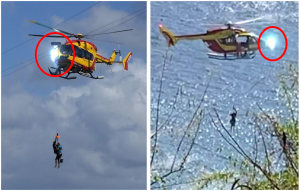
Striking Second Cable – First Arc on Nose: Sécurité Civile SAR Airbus Helicopters EC145 F-ZBQK (Credit: via BEA-E)

Striking Second Cable – Arc on Hoist Strut: Sécurité Civile SAR Airbus Helicopters EC145 F-ZBQK (Credit: via BEA-E)
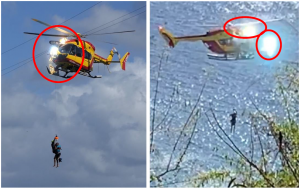
Striking Second Cable – Arc on Cowling Sécurité Civile SAR Airbus Helicopters EC145 F-ZBQK (Credit: via BEA-E)
The winch cable failed and both survivor and winchman fell into the sea from 45-60 ft. They were able to swim to shore and the helicopter landed safely at the airport.
The Safety Investigation and Analysis
The employee of a beachfront restaurant who raised the alarm about the jet-skier being in difficulties claims to have mentioned the presence of the power line to CROSS AG. The BEA-E interviews at CROSS AG proved “to be contradictory”. The recording of those particular phone calls had not been retained either. It is undisputed however that the helicopter crew did not receive any warning about the presence of the power line.
Damage was evident on several parts of the airframe.
Laboratory examination showed that the hoist cable failed due to arc burn damage.
From 3 videos and CVFDR data, the BEA-E created reconstruction below:
The crew were not familiar with the small cove. The power cables were unmarked and had a diameter of just 7.82 mm. They were dark in colour, with little contrast with the landscape beyond. They were the only power lines on the island to cross water. These medium voltage cables were neither marked on local maps or aeronautical charts (though high and very high voltage cables elsewhere on the island where).
BEA-E say:
Even at low speed, the characteristics of the cables and their environment make this power line a very difficult obstacle to detect along the axis and the height of arrival of the helicopter.
In contrast the six posts supporting the cables (three on each side of the cove) were detectable.

Fond Bellemare Cove Electricity Poles (After Accident): Sécurité Civile SAR Airbus Helicopters EC145 F-ZBQK (Credit: BEA-E)
Hence, BEA-E observe that:
An active search for posts…could have made it possible to detect its presence and to deduce a risk of the presence of cables.
The BEA-E comment that:
The entire crew was experienced, although the pilot was mainly experienced in mountain rescues. The three crew members had all made a significant number of hoist rescues.
The perception of the emergency level of the mission resulted in a great motivation of the crew to take off as quickly as possible. …time pressure…can lead to a deterioration of judgment and a focusing of attention
on the victim, to the detriment of taking into account the risks.
The time pressure may have also explained why the crew ere not wearing life jackets (required for all over water taskings). That and the rapid arrival may explain why the hoisting brief was missed and with the pilots mountain experience, why the Emergency Flotation System (EFS) floats were not armed when the aircraft was below 80 knots.
Sécurité Civile SAR procedures require a ‘recognition circuit’ before coming into the hover for hoisting. The BEA-E note that the crew made a figure of 8 pass, initially flying past the survivor without spotting him before doubling back.
They opine this did not meet the intent of a ‘recognition circuit’.
A misrepresentation of the situation led the crew to believe that they were safe from any obstacle above the water and contributed to the non-detection of the electric cables.
We’d also observe that when they did spot the survivor attention may have focused on the obvious obstacle of the yacht’s mast. One the survivor was picked up BEA-E note that the pilot’s attention switched to choosing the drop off area.
BEA-E Conclusions
The cause of the wire strike was the non-detection by the crew.
This non-detection was due to:
- the characteristics of the power line and its environment (dry vegetation in the background);
- the absence of a map marking the presence of the power line;
- the focusing of the pilot’s and winch operator’s attention down;
- the lack of familiarity with the drop-off area;
- likely overconfidence;
- the absence of mention by the CROSS AG of the presence of the electric line.
BEA-E Safety Recommendations
These included
- recording of communications to/from the rescue coordination centre (RCC)
- conveying comprehensive information from the RCC
- sharing intelligence on obstacle data between state air operator agencies (Gendarmerie, Customs, Navy and Sécurité Civile)
- reinforcing procedural adherance including “studying in particular the possibility of analyzing anonymously and randomly the voice data of the CVFDR)
- adopting a a pre-flight briefing called MEMO (Mission / personal protective Equipment / Mission equipment / Obstacles) used at some bases
- studying cable detection technology
- stressing the importance of “land as soon as possible” after an obstacle strike
Safety Resources
The European Safety Promotion Network – Rotorcraft (ESPN-R) has published this video and guidance with EASA:
See also: Avoiding Wire Strikes
Our past articles include:
- Norwegian HEMS Landing Wirestrike
- Firefighting Helicopter Wire Strike
- Fatal Wire Strike on Take Off from Communications Site
- Beware Last Minute Changes in Plan
- Helicopter Tail Rotor Strike from Firefighting Bucket
- Helicopter Wirestrike During Powerline Inspection
- Fatal MD600 Collision With Powerline During Construction
- SAR Helicopter Loss of Control at Night: ATSB Report
- HF Lessons from an AS365N3+ Gear Up Landing
- Tail Rotor Pitch Control Loss During Hoisting
- Fatal Fall From B429 During Helicopter Hoist Training
- Marine Pilot Transfer Winching Accident
- Swedish Special Forces SPIES and Military SMS
- Hoist Assembly Errors: SAR Personnel Dropped Into Sea
- SAR Crew With High Workload Land Wheels Up on Beach
- Fall From Stretcher During Taiwanese SAR Mission (NASC AS365N2 NA-104)
- Fatal Taiwanese Night SAR Hoist Mission (NASC AS365N3 NA-106)
- EASA Decisions on Management of Aeronautical Databases / Part-DAT
- EC135P2 Spatial Disorientation Accident
- EC135P2+ Loss of NR Control During N2 Adjustment Flight
- Austrian Police EC135P2+ Impacted Glassy Lake
- That Others May Live – Inadvertent IMC & The Value of Flight Data Monitoring
- HEMS S-76C Night Approach LOC-I Incident
- HEMS A109S Night Loss of Control Inflight
- ‘Procedural Drift’: Lynx CFIT in Afghanistan
- US Fatal Night HEMS Accident: Self-Induced Pressure & Inadequate Oversight
- HEMS Black Hole Accident: “Organisational, Regulatory and Oversight Deficiencies”
- Taiwan NASC UH-60M Night Medevac Helicopter Take Off Accident
- Italian HEMS AW139 Inadvertent IMC Accident
- Night Offshore Windfarm HEMS Winch Training CFIT
- Fatal MD600 Collision With Powerline During Construction
- HEMS AW109S Collided With Radio Mast During Night Flight
- SAR Helicopter Loss of Control at Night: ATSB Report
- UPDATE 11 May 2020: European Search and Rescue (SAR) Competition Bonanza
- UPDATE 30 May 2020: Fatal Wisonsin Wire Strike When Robinson R44 Repositions to Refuel
- UPDATE 6 June 2020: Fish Spotting Helicopter Strikes Glassy Sea
- UPDATE 26 July 2020: Impromptu Landing – Unseen Cable
- UPDATE 20 September 2020: Hanging on the Telephone… HEMS Wirestrike
- UPDATE 24 October 2020: Sécurité Civile EC145 Mountain Rescue Blade Strike
- UPDATE 23 January 2021: US Air Ambulance Near Miss with Zip Wire and High ROD Impact at High Density Altitude
- UPDATE 5 March 2021: Wire Strike on Unfamiliar Approach Direction to a Familiar Site
- UPDATE 15 May 2021: Military SAR H225M Caracal Double Hoist Fatality Accident
- UPDATE 17 July 2021: Sécurité Civile EC145 Mountain Rescue Main Rotor Blade Strike Leads to Tail Strike
- UPDATE 31 July 2021: Low Recce of HEMS Landing Site Skipped – Rotor Blade Strikes Cable Cutter at Small, Sloped Site
- UPDATE 21 August 2021: Air Methods AS350B3 Night CFIT in Snow
- UPDATE 19 September 2021: A HEMS Helicopter Had a Lucky Escape During a NVIS Approach to its Home Base
- UPDATE 14 August 2022: Second Time Unlucky: Fatal Greek Wirestrike High-Wire Illusion
- UPDATE 3 September 2022: Garbage Pilot Becomes Electric Hooker
- UPDATE 11 February 2024: Air Ambulance Night Wirestrike at Poorly Chosen Landing Site
On error management:
…and our review of The Field Guide to Understanding Human Error by Sidney Dekker presented to the Royal Aeronautical Society (RAeS): The Field Guide to Understanding Human Error – A Review
SAR Consultancy: Procurement, Tenders, Contacts and In-Service Assurance and Aviation Advice
In September 2017 one European Coast Guard selected Aerossurance to be their new aviation consultants after a competitive tender with 7 bidders. In July 2018 Aerossurance started work supporting a second European Coast Guard with a procurement project. The Aerossurance team is and has supported humanitarian aid agencies, air ambulance charities, military air arms, environmental agencies and blue chip energy companies on other emergency service and special mission aviation projects around the world. Covid-19 compatible PPE equipment and procedures has been a recent topical issue.
The Tender Trap: SAR and Medevac Contract Design: Aerossurance’s Andy Evans discusses how to set up clear and robust contracts for effective contracted SAR and HEMS operations.





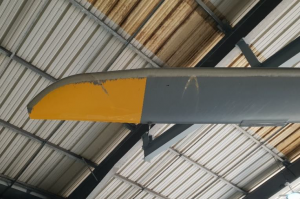
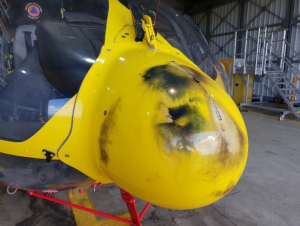
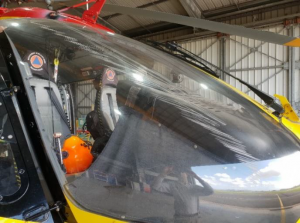


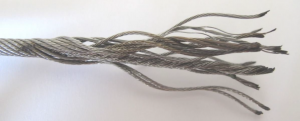
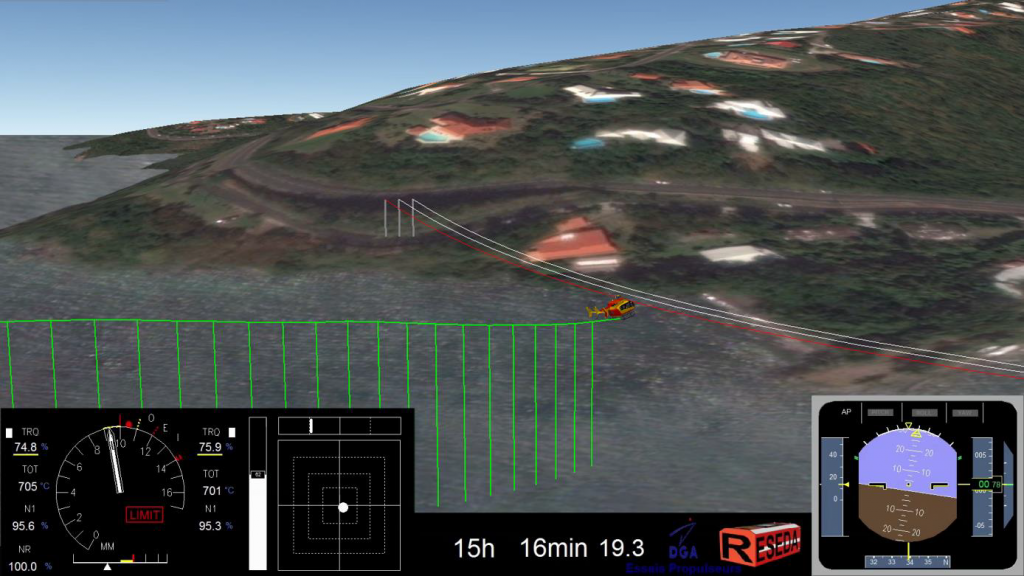
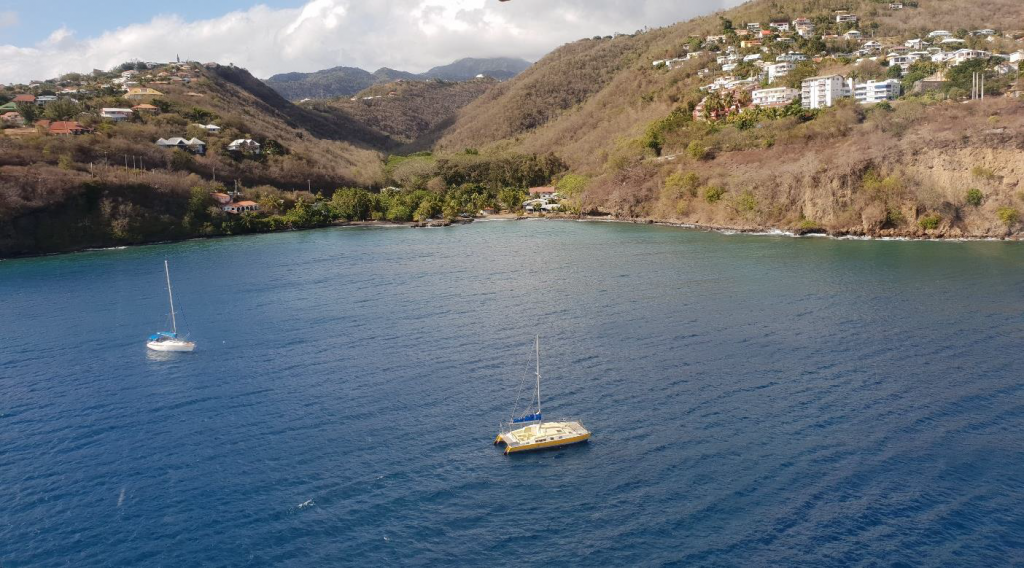

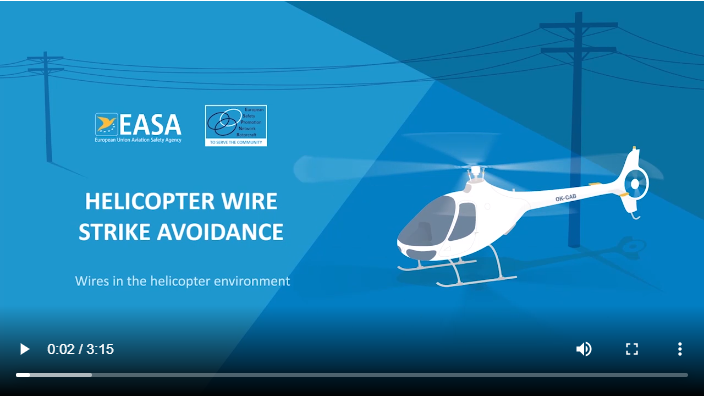
Recent Comments